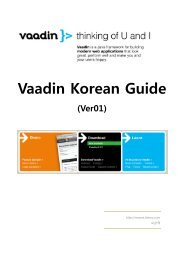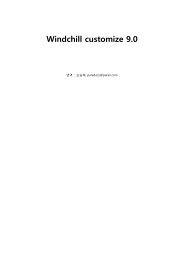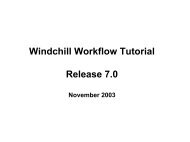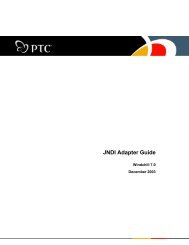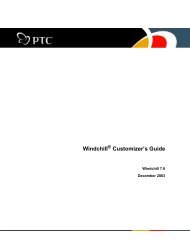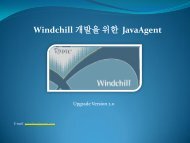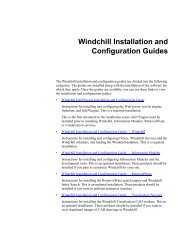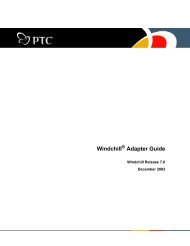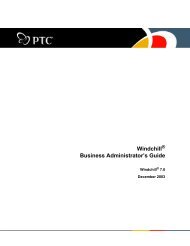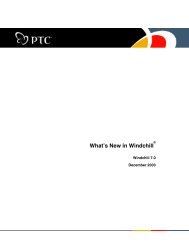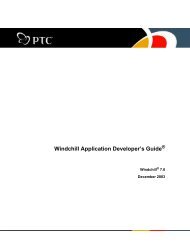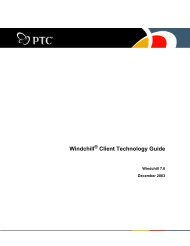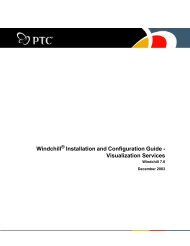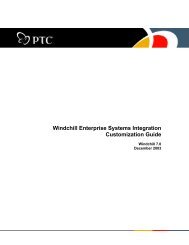Windchill System Administrator's Guide
Windchill System Administrator's Guide
Windchill System Administrator's Guide
Create successful ePaper yourself
Turn your PDF publications into a flip-book with our unique Google optimized e-Paper software.
customizations operate together. After the validation is complete, you collect<br />
all the site customizations together for easy deployment to production.<br />
• Install and Deploy. In the second execution, the <strong>Windchill</strong> Service Pack<br />
installer executes on your production system. During this execution you direct<br />
the installer to pick up your collection of previously prepared site<br />
customizations and install them. This is done after PTC files are installed, but<br />
before the <strong>Windchill</strong> Service Pack housekeeping operations. After the<br />
<strong>Windchill</strong> Service Pack completes, the system is ready to be returned to<br />
production.<br />
In order for the <strong>Windchill</strong> Service Pack to be used in this fashion, you must<br />
manage your modifications to the PTC files as prescribed by the maintenance best<br />
practices.<br />
When you execute the <strong>Windchill</strong> Service Pack installer, it first determines which<br />
files should be installed onto your system. It does this by finding out which<br />
products are installed in the installation directory its being executed on and what<br />
datecode versions are already present. This results in the following behavior:<br />
• If you do not have a product for which there are updates, the updates are not<br />
installed.<br />
• Previously installed updates are not re-applied at every execution of the<br />
<strong>Windchill</strong> Service Pack. This means that if there were no changes for a<br />
product between different datecodes of the <strong>Windchill</strong> Service Pack, and<br />
you've already installed the <strong>Windchill</strong> Service Pack from the earlier datecode,<br />
they will not be re-installed on the next <strong>Windchill</strong> Service Pack installation.<br />
• The installer will only update locale specific resources on your system if it<br />
finds that those locales were previously installed and registered through an<br />
installation of the <strong>Windchill</strong> Language Pack.<br />
These features are intended to minimize the time it takes to install the <strong>Windchill</strong><br />
Service Pack2 . In particular this avoids re-installing updates to site modified files<br />
when you have previously incorporated those changes.<br />
Note: Depending on what <strong>Windchill</strong> products you have installed and how they<br />
are deployed across one or more computer systems, you may have to execute the<br />
<strong>Windchill</strong> Service Pack installer in multiple installation directories on multiple<br />
computers.<br />
Each execution of the <strong>Windchill</strong> Service Pack updates all the products it finds in a<br />
single installation directory, but it can only address one installation directory at a<br />
time. For this reason, one of the best practices is to keep a list of all the systems on<br />
2. After you perform a first time installation any 7.0 product covered by the <strong>Windchill</strong> Service<br />
Pack, you should re-execute the <strong>Windchill</strong> Service Pack to install any recent updates and<br />
ensure the product is at a compatible level with the other products on your system. You should<br />
also repeat the <strong>Windchill</strong> Service Pack installation if add a new locale to your system through<br />
the <strong>Windchill</strong> Language Pack.<br />
Administering Runtime Services 1-43



